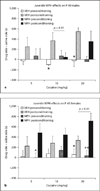Juvenile methylphenidate exposure and factors that influence incentive processing
- PMID: 19372691
- PMCID: PMC5268706
- DOI: 10.1159/000207498
Juvenile methylphenidate exposure and factors that influence incentive processing
Abstract
Methylphenidate (MPH) is one of the few psychotropic agents approved for use in pediatric populations, underscoring the importance of elucidating any long-term consequences following exposure to this agent. Here, we examined the influence of several variables (i.e. age of assessment, age of exposure, sex, route of administration) on the effect of chronic low-dose MPH (2 mg/kg, twice daily) exposure on place conditioning to cocaine. Juvenile exposure to MPH, but not later exposure, resulted in aversions to cocaine-paired environments when assessed in young adult male rats, but not those entering adolescence. Juvenile MPH enhanced place preferences for cocaine-paired environments in female adolescent rats. The route of administration (i.p. injection or oral ingestion) did not produce enduring differential effects on behavior, and D-MPH was confirmed as the active enantiomer. These observations add to the growing literature on the enduring effects of MPH exposure, and highlight the need for more research in females.
2009 S. Karger AG, Basel.
Figures






Similar articles
-
Prenatal exposure to methylphenidate affects the dopamine system and the reactivity to natural reward in adulthood in rats.Int J Neuropsychopharmacol. 2014 Oct 31;18(4):pyu044. doi: 10.1093/ijnp/pyu044. Int J Neuropsychopharmacol. 2014. PMID: 25522388 Free PMC article.
-
The effects of chronic methylphenidate administration on operant test battery performance in juvenile rhesus monkeys.Neurotoxicol Teratol. 2010 Mar-Apr;32(2):142-51. doi: 10.1016/j.ntt.2009.08.011. Epub 2009 Sep 6. Neurotoxicol Teratol. 2010. PMID: 19737611 Free PMC article.
-
Characterization of anxiety-related responses in male rats following prolonged exposure to therapeutic doses of oral methylphenidate.Pharmacol Biochem Behav. 2009 Oct;93(4):451-9. doi: 10.1016/j.pbb.2009.06.007. Epub 2009 Jun 21. Pharmacol Biochem Behav. 2009. PMID: 19540871
-
Differential pharmacokinetics and pharmacodynamics of methylphenidate enantiomers: does chirality matter?J Clin Psychopharmacol. 2008 Jun;28(3 Suppl 2):S54-61. doi: 10.1097/JCP.0b013e3181733560. J Clin Psychopharmacol. 2008. PMID: 18480678 Review.
-
Does chirality matter? pharmacodynamics of enantiomers of methylphenidate in patients with attention-deficit/hyperactivity disorder.J Clin Psychopharmacol. 2008 Jun;28(3 Suppl 2):S62-6. doi: 10.1097/JCP.0b013e3181744aa6. J Clin Psychopharmacol. 2008. PMID: 18480679 Review.
Cited by
-
Juvenile exposure to methylphenidate and guanfacine in rats: effects on early delay discounting and later cocaine-taking behavior.Psychopharmacology (Berl). 2019 Feb;236(2):685-698. doi: 10.1007/s00213-018-5096-0. Epub 2018 Nov 9. Psychopharmacology (Berl). 2019. PMID: 30411140
-
Neurobehavioral changes arising from early life dopamine signaling perturbations.Neurochem Int. 2020 Jul;137:104747. doi: 10.1016/j.neuint.2020.104747. Epub 2020 Apr 20. Neurochem Int. 2020. PMID: 32325191 Free PMC article. Review.
-
Effects of psychotropic drugs on second messenger signaling and preference for nicotine in juvenile male mice.Psychopharmacology (Berl). 2014 Apr;231(8):1479-92. doi: 10.1007/s00213-014-3434-4. Epub 2014 Jan 23. Psychopharmacology (Berl). 2014. PMID: 24452697 Free PMC article.
-
Developmental trajectories during adolescence in males and females: a cross-species understanding of underlying brain changes.Neurosci Biobehav Rev. 2011 Aug;35(8):1687-703. doi: 10.1016/j.neubiorev.2011.04.013. Epub 2011 May 12. Neurosci Biobehav Rev. 2011. PMID: 21600919 Free PMC article. Review.
-
Sensitive periods of substance abuse: Early risk for the transition to dependence.Dev Cogn Neurosci. 2017 Jun;25:29-44. doi: 10.1016/j.dcn.2016.10.004. Epub 2016 Oct 29. Dev Cogn Neurosci. 2017. PMID: 27840157 Free PMC article. Review.
References
-
- Wagner FA, Anthony JC. From first drug use to drug dependence; developmental periods of risk for dependence upon marijuana, cocaine, and alcohol. Neuropsychopharmacology. 2002;26:479–488. - PubMed
-
- Johnston LD, et al. Monitoring the future. National results on adolescent drug use. Overview of key findings. 2007
-
- Rapoport JL, Buchsbaum MS, Zahn TP, Weingartner H, Ludlow C, Mikkelsen EJ. Dextroamphetamine: cognitive and behavioral effects in normal prepubertal boys. Science. 1978;199:560–563. - PubMed
-
- Wilens TE, Faraone SV, Biederman J, Gunawardene S. Does stimulant therapy of attention-deficit/hyperactivity disorder beget later substance abuse?. A meta-analytic review of the literature. Pediatrics. 2003;111:179–185. - PubMed
-
- Dafny N, Yang PB. The role of age, genotype, sex, and route of acute and chronic administration of methylphenidate: a review of its locomotor effects. Brain Res Bull. 2006;68:393–405. - PubMed
Publication types
MeSH terms
Substances
Grants and funding
LinkOut - more resources
Full Text Sources

